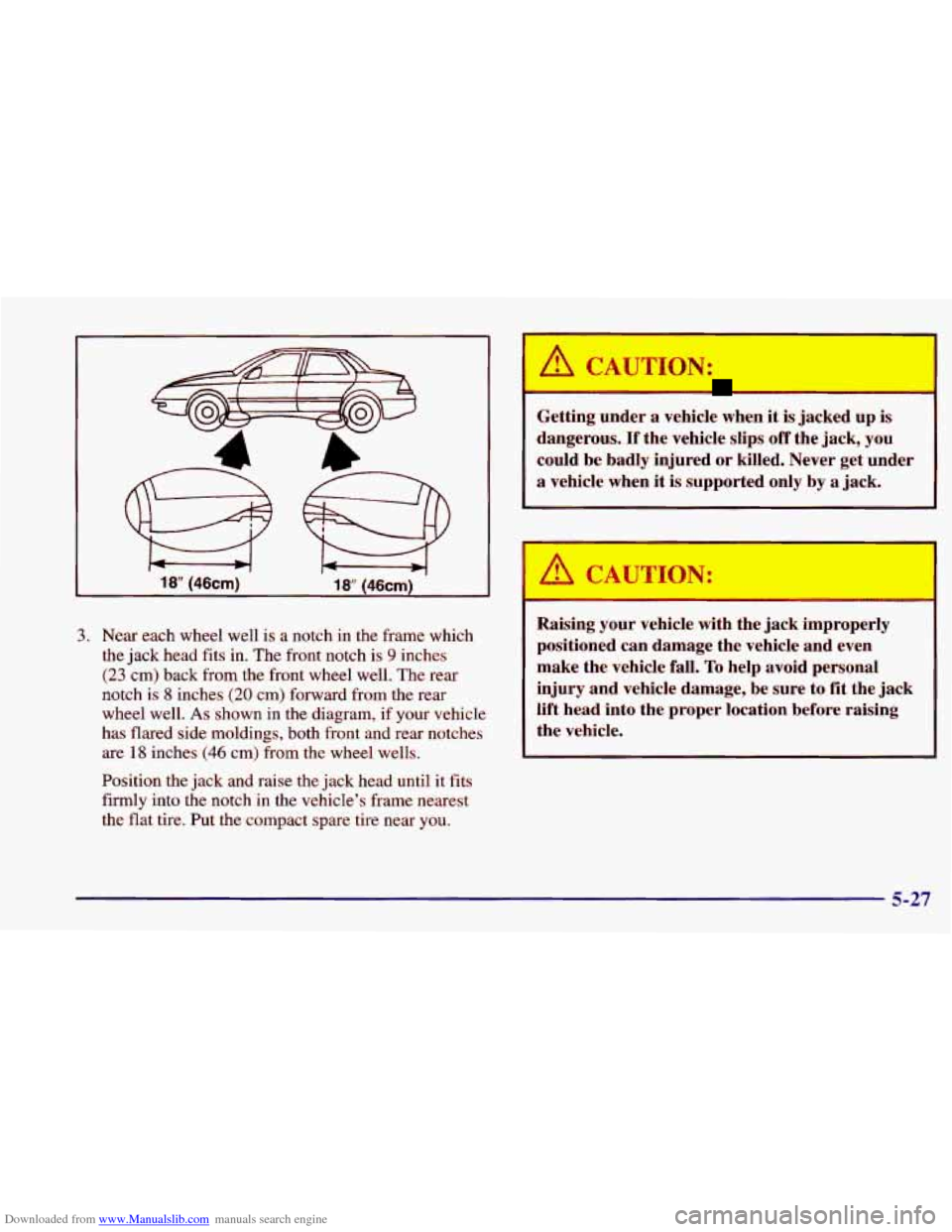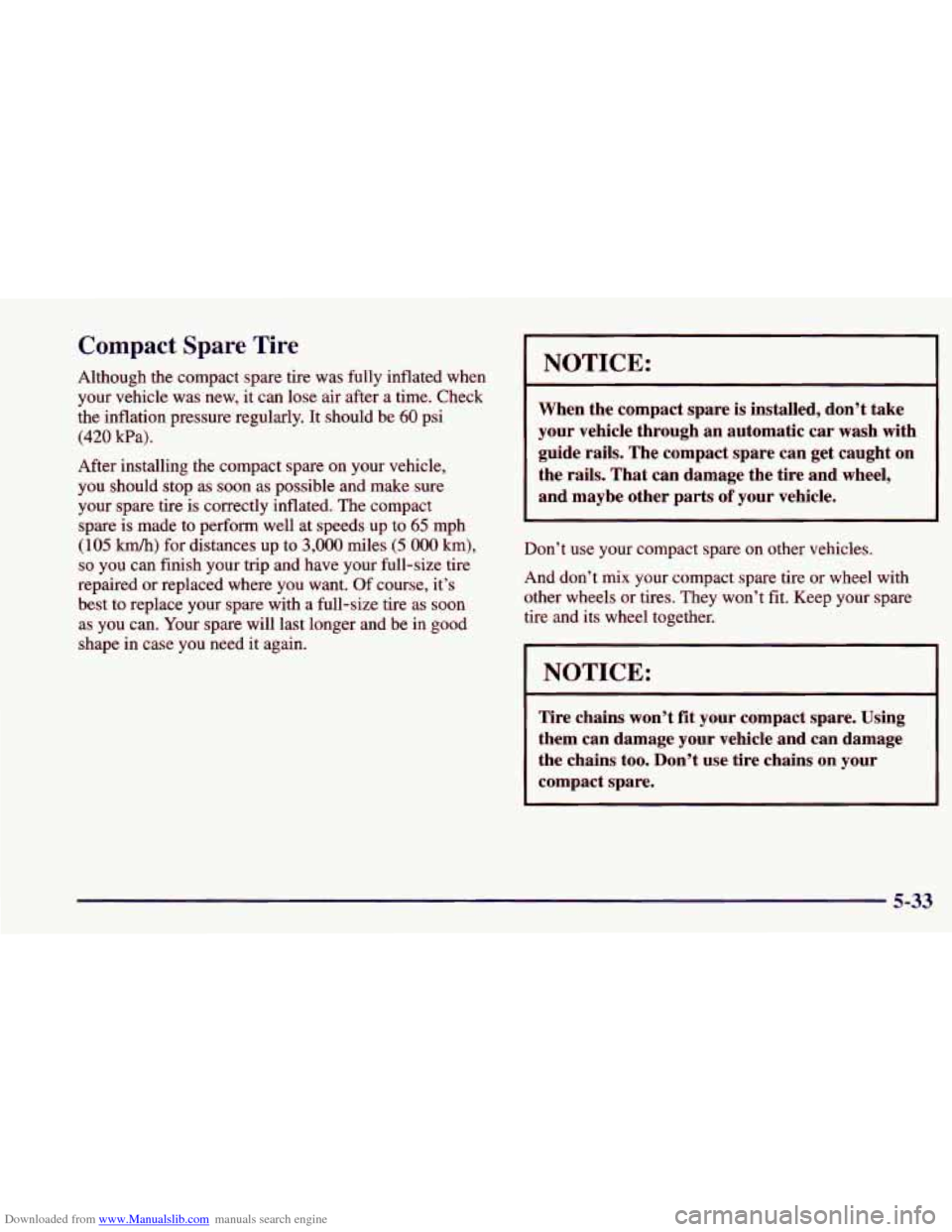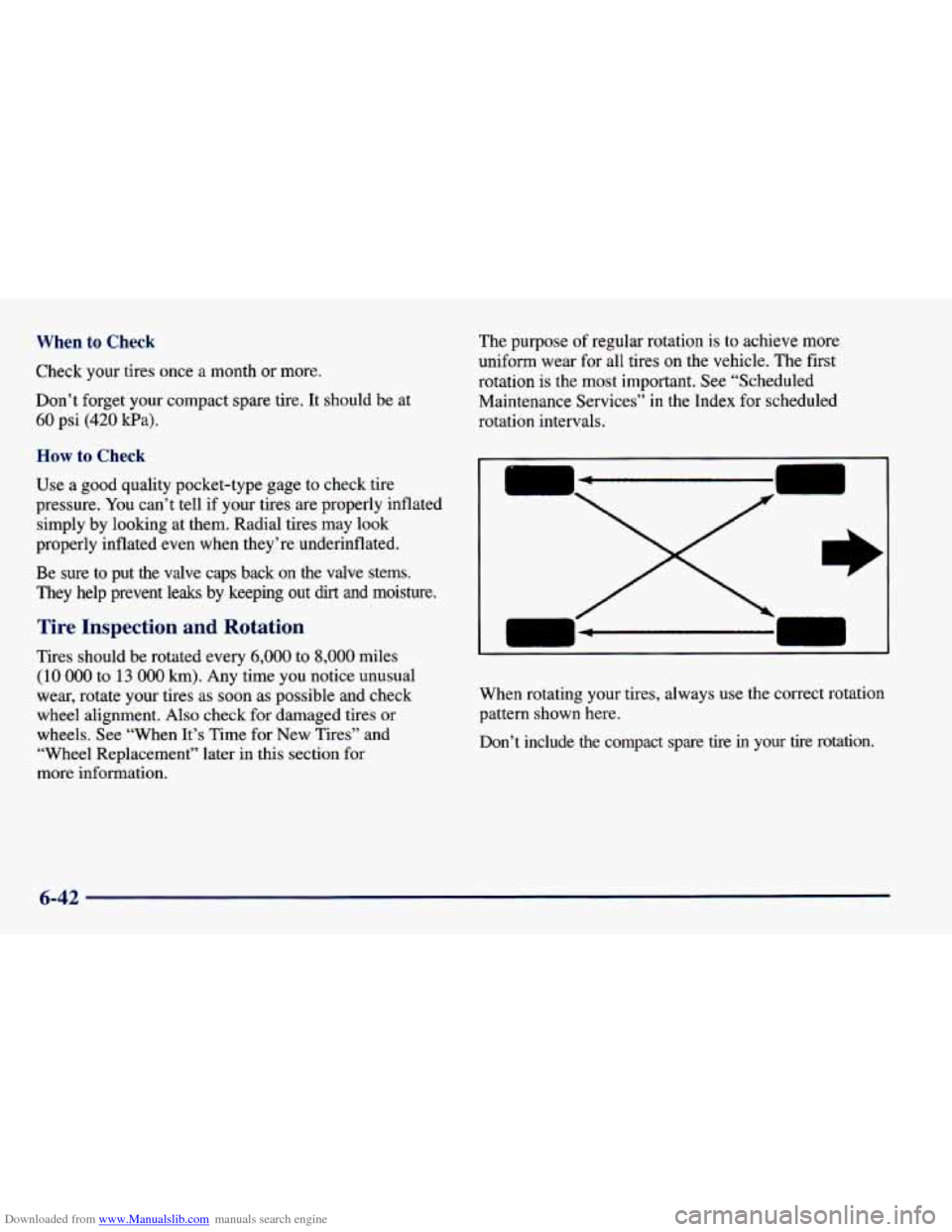Page 247 of 400
Downloaded from www.Manualslib.com manuals search engine 4 Turn the wing bolt to the
' left and remove it. Then
lift
off the adapter and
remove the spare tire.
I
I
Remove the jack and wheel wrench from the trunk. Your
vehicle's jack and wheel wrench are stored in
a foam
tray. Remove the band around the jack.
1 L
The tools you'll be using include the jack (A) and
wheel wrench
(B).
5-25
Page 248 of 400
Downloaded from www.Manualslib.com manuals search engine Removing the Flat Tire and Installing the
Spare Tire
1. Using the wheel wrench,
remove the plastic nut
,. - -. caps (if equipped).
2. On some models, a cover plate must be removed to
find the wheel nuts. Carefully use the wedge end
of
the wheel wrench to pry it off.
Then use the wheel wrench
to loosen all the wheel
nuts. Don’t remove them yet.
5-26
Page 249 of 400

Downloaded from www.Manualslib.com manuals search engine 18” (46cm) 18‘ (46cm)
3. Near each wheel well is a notch in the frame which
the jack head fits in. The front notch is
9 inches
(23 cm) back from the front wheel well. The rear
notch is
8 inches (20 cm) forward from the rear
wheel well.
As shown in the diagram, if your vehicle
has flared side moldings, both front and rear notches
are 18 inches (46 cm) from the wheel wells.
Position the jack and raise the jack head until it fits
firmly into the notch in the vehicle’s frame nearest
the flat tire. Put the compact spare tire near
you.
A CAUTION:
G&ng under a vehicle wl1m it is JaLried uk 1s
dangerous. If the vehicle slips off the jack, you
could be badly injured or killed. Never get under
a vehicle when it is supported only by a jack.
I
Raising your vehicle with the jack improperly
positioned can damage the vehicle and even
make the vehicle fall.
To help avoid personal
injury and vehicle damage, be sure to
fit the jack
lift head into the proper location before raising
~ the vehicle.
Page 250 of 400
Downloaded from www.Manualslib.com manuals search engine 4. Raise the vehicle by rotating the jack handle to the
right. Raise the vehicle far enough
off the ground so
there is enough room for the spare tire to fit.
5. Remove all of the wheel nuts.
6. If you have a wheel cover, use your fingers to
carefully pull the wheel cover from the wheel. Then
remove the flat tire.
5-28
Page 251 of 400
Downloaded from www.Manualslib.com manuals search engine 7. Remove any rust or dirt
from the wheel bolts,
mounting surfaces and
spare wheel.
Rust or dirt on the wtd, or on thc ," ;o
which it is fastened, can make the wheel nuts
become loose
after a time. The wheel could come
off and cause an accident. When you change a
wheel, remove any rust or dirt from the places
where the wheel attaches
to the vehicle. In an
emergency,
you can use a cloth or a paper towel
to do this; but be sure to use
a scraper or wire
brush later,
if you need to, to get all the rust or
dirt off.
h CAUTION: I
Never use oil or grease on studs or nuts. If you
do, the nuts might come loose, Your wheel could
fall
off, causing a serious accident,
1 wheel-mounting
surface. Replace the
wheel nuts with the
rounded end
of the nuts
toward the wheel.
Tighten each nut
by
hand or with the wheel
wrench until the wheel
is held against the hub.
8. Place the spare on the
5-29
Page 253 of 400
Downloaded from www.Manualslib.com manuals search engine Store the wheel cover and wheel nut caps in the trunk
until you have the flat tire repaired or replaced.
I NOTICE:
Wheel covers won’t fit on your compact spare. If
you try to put a wheel cover on your compact
spare, you could damage the cover or the spare.
Storing the Flat Tire and Tools
Storing a jack, a tire or other equipment in the
passenger compartment
of the vehicle could
cause injury. In a sudden stop or collision, loose
equipment could strike someone. Store all these
in the proper place.
m H
A. Wrench
B. Jack
C. Flat Road Tire
D. Adapter
E. Extension
E Wing Bolt
G. Cover
H. Nut (Extension Installed)
Store the flat tire in the compact spare tire compartment
and secure the adapter, extension (aluminum wheel
only) and wing bolt. Store the
jack and wheel wrench in
the foam tray.
5-31
Page 255 of 400

Downloaded from www.Manualslib.com manuals search engine Compact Spare Tire
Although the compact spare tire was fully inflated when your vehicle was new, it can lose air after a time. Check
the inflation pressure regularly. It should be
60 psi
(420 Wa).
After installing the compact spare on your vehicle,
you should stop as soon as possible and make sure
your spare
tire is correctly inflated. The compact
spare is made to perform well
at speeds up to 65 mph
( 105 km/h) for distances up to 3,000 miles (5 000 km),
so you can finish your trip and have your full-size tire
repaired or replaced where you want.
Of course, it’s
best to replace your spare with a full-size tire as soon
as you can. Your spare will last longer and be in good
shape in case you need it again.
NOTICE:
When the compact spare is installed, don’t take
your vehicle through an automatic car wash with
guide rails. The compact spare can get caught on
the rails. That can damage the tire and wheel,
and maybe other parts
of your vehicle.
Don’t use your compact spare on other vehicles.
And don’t mix your compact spare tire or wheel with
other wheels or tires. They won’t fit. Keep your spare
tire and its wheel together.
NOTICE:
Tire chains won’t fit your compact spare. Using
them can damage your vehicle and can damage
the chains too. Don’t use tire chains
on your
compact spare.
5-33
Page 300 of 400

Downloaded from www.Manualslib.com manuals search engine When to Check
Check your tires once a month or more.
Don’t forget your compact spare tire. It should be at
60 psi (420 kPa). The purpose
of regular rotation is to achieve more
uniform wear for all tires on the vehicle. The first
rotation is the most important. See “Scheduled
Maintenance Services”
in the Index for scheduled
rotation intervals.
How to Check
Use a good quality pocket-type gage to check tire
pressure. You can’t tell if your tires are properly inflated
simply by looking at them. Radial tires may look
properly inflated even when they’re underinflated.
Be sure to put the valve caps back on the valve stems.
They help prevent leaks by keeping out
dirt and moisture.
Tire Inspection and Rotation
Tires should be rotated every 6,000 to 8,000 miles
( 10 000 to 13 000 km). Any time you notice unusual
wear, rotate your tires
as soon as possible and check
wheel alignment. Also check for damaged tires or
wheels. See “When It’s Time for New Tires” and
“Wheel Replacement” later in this section for
more information. When rotating your tires, always use the correct rotation
pattern shown here.
Don’t include the compact
spare tire in your tire rotation.
6-42